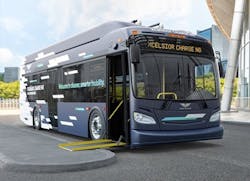Whatever the promises made, the future of EV adoption is not here yet.
The grid is not ready. Drivers don’t see a clear pathway yet to avoid range anxiety. You can’t get the same bang for your buck with electrons as you can with gas or diesel.
These criticisms of electric vehicles are said nearly everywhere among those who are not true believers. And, in many ways they are dead-on. Widespread e-mobility may be coming, but it’s not anywhere near here so far.
Slowly and surely, though, it’s gaining momentum. You might see a Tesla parked at a rest stop in Colby, Kansas, or moving through the streets of Brooklyn. A buzzing Amazon van delivering your latest order. Like the start of a river, little rivulets are forming and moving here and there.
The commercial and industrial sector certainly is perhaps moving faster than the solitary driver in embracing the fact that the current that is coming.
“The rate of EV adoption in the south is slow,” David Ellis, chief customer officer of New Orleans-based utility Entergy Corp., acknowledged during an opening day session Wednesday at the T&D World Conference and Exhibition in Charlotte. “But the rate of our C&I customers adopting EVs is much faster.”
And there you have it, the future arriving. The C&I sector, already embracing the energy transition for both environmental and cost-benefit motivations, is finding traction in fleet electrification. They see margins gained and carbon dioxide avoided. Win-win.
This momentum was even more in focus in a later T&D World Conference session featuring Dave Schaller, the industry engagement director at the trucking industry-supported North American Council for Freight Efficiency. The NAFCE was founded originally to help solve issues of diesel efficiency but has seen the future and began studying and reporting on fleet electrification.
Schaller, however, noted that the conversation between fleet owners and utilities is still in an awkward stage. He compared it to a junior high school prom, with guys on one side, girls on the other and no one sure how to approach each other.
“The conversation is very challenging,” Schaller told the packed crowd at the Downtown Sheraton in Charlotte.
The inaugural T&D World Conference 2022 in Charlotte was a fun success connecting utilities and grid suppliers
Join us this September 2023 for the new T&D World C&E in Sacramento with SMUD as Host Utility
And yet the rivulets are moving, gathering and gaining force. In the trucking industry, there are several levels of size, route and purpose, so far showing that electrification makes a lot of sense for fixed and short-haul, medium-duty carriers, but not yet for the cross-country haulers.
“Duty cycle absolutely is important,” Schaller pointed out.
The NACFE is intently studying this issue, and also is now publicly asking utilities to get onboard and join them. What its Roll-E reports have found is extremely encouraging for those fleet planners determining whether e-mobility is right for their school buses, mass transits, warehouse yard tractors and e-commerce vans.
“Battery electric for terminal trucks are phenomenal,” he said.
For instance, the NACFE found that step vans studied would spend more than $10,000 per van in gasoline costs (and that analysis was done when gas was at $2.98 per gallon). By comparison, the electric version of the step van would spend slightly under $2,000 in fuel cost.
And if all commercial step vans were converted to electric it might help eliminate 43,476 metric tons of CO2.
“The use cases show that box trucks, terminal trucks and step vans are ready,” Schaller said. “Long haul and regional haul not so much.”
For full-on adoption, the fleet industry and utilities still need to get off the sideline and dance.
“Very strategic questions need to be asked,” Schaller noted.
Beyond the NACFE presentation at T&D World, many entities are working together on the west coast and elsewhere to try and solve these long-haul, sleeper tractor challenges in charging infrastructure and grid readiness. One group of utilities is banding together to create an I-5 charging corridor up and down the coast from southern California to Washington state, while others are working on alleviating range fears in the Midwest and East Coast.
The T&D World Conference and Exhibition continues through Friday. Host utility is Duke Energy.
-- -- --
(Rod Walton, senior editor for EnergyTech, is a 14-year veteran of covering the energy industry both as a newspaper and trade journalist. He can be reached at [email protected]).
Follow us on Twitter @EnergyTechNews_ and @rodwaltonelp and on LinkedIn






